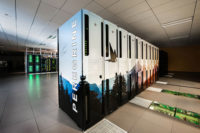A district heating scheme in Finland has harnessed waste heat generated by a computer center to heat homes. The project uses an advanced heat pump system based on high-performance Bitzer compressors.
Heat transfer specialist Calefa Oy designed and built the scheme in Mäntsälä, Finland.
The key design objective was to efficiently harness waste heat produced by servers at the local computing center, operated by Yandex Finland, and use it for district heating in order to protect the environment and reduce energy costs for the municipality.
The installation also has the secondary effect of providing an effective means of cooling the computer center, which would otherwise have to be cooled by direct mechanical means or circulation of large volumes of fresh air, both of which are energy-intensive.
Heat generated by servers is extracted in the form of hot air, which is passed over high-efficiency heat exchangers. This is used to heat water to around 40°C, which in turn is fed to a series of high-performance heat pumps.
The heat pumps raise the temperature of the water to 85°C, which is then circulated through the town’s district heating system. Because of the inherent efficiency of the heat pumps, and the careful design of the system, the process captures some 75 percent of the energy produced by the servers as waste heat.
At present, the project has a total capacity of 4 MW and heats about 1,500 homes. In the future, the plan is to extend the scheme so that heating can be provided to 4,000 homes. It is believed to be the first time such a large amount of waste heat from a computing center has been directly harnessed for use in district heating.
To increase the water temperature to 85°C, powerful and efficient heat pumps are required. At the heart of the installation are 24 six-cylinder Bitzer Ecoline compressors, each delivering flow rates of up to 150 m3/h (at 50 Hz).
The environmental benefits of the scheme are substantial. In the first phase, CO2 emissions will be reduced by 4,000 metric tons per year. When the project has been completed, this will rise to 11,000 metric tons of CO2 each year.
The project has enabled the town to meet European Union targets to reduce carbon emissions by 40 percent by 2030, well ahead of the statutory deadline.
“We chose Bitzer compressors because of their reputation for high quality, reliability, and performance,” said Vesa Tamminen, CEO of Calefa. “Resilience and long service life are vital in such an application. Also, from past experience we know we can work together well with Bitzer and can rely on their support.”
Marcus Levy, technical manager of Bitzer UK, said: “The project provides an excellent demonstration of the enormous potential for harnessing waste energy from computer server facilities. There are many such centers in the U.K., and most suffer from challenging issues of waste heat dissipation.
“Throwing large amounts of direct expansion (DX) cooling energy at them is wasteful on a number of levels, not to mention the environmental impact of additional carbon emissions above and beyond the energy used to operate the servers.
“It makes absolute sense from both an economic and environmental point of view to harness this waste heat and make good social use of it by heating homes.”
He added: “The key to making projects work is obviously reasonable proximity of large computer facilities to residential and commercial developments. Given this, there is no reason we can’t replicate the approach taken by the Finnish project in the U.K.
“We have the equipment and technical expertise and are here to support developers every step of the way.”
Content for the European Spotlight is provided courtesy of Refrigeration and Air Conditioning Magazine, London. For more information, visit www.racplus.com.
Publication date: 10/10/2016
Want more HVAC industry news and information? Join The NEWS on Facebook, Twitter, and LinkedIn today!









